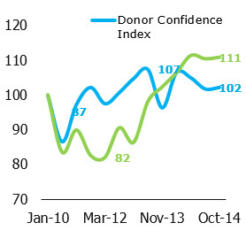The public’s optimism about giving to charity has not grown as fast as consumer spending, according to a new “donor confidence index” published today by research consultancy nfpSynergy.
The index also shows the public's enthusiasm for giving fell slightly over the nine months to October 2014.
The index measures people’s likelihood of giving to charity, based on a number of measures including how many people are giving to charity, how much they are giving, to how many charities and in what ways; as well as their predictions for the future and reports of changes in recent giving.
The data was already collected by nfpSynergy as part of its work on awareness of charity. It will now be updated every three months.
It tracks changes against the consumer confidence index, a 50-year-old measure which tracks individuals’ propensity to spend. While consumer confidence has risen by 11 points since January 2010, at the heart of the recession, donor confidence has only risen by 2 per cent.
However Cian Murphy, head of data analysis at nfpSynergy, said that donations are widely believed to have held up better than consumer spending over the course of the recession, suggesting that the two indices may have been at very different points in their cycle when they started out.
Murphy said there were still many unanswered questions about the index.
“We know that consumer confidence is a lag indicator of how consumer spending will behave, but quite a good one,” he said. “This index is an attempt to measure the same thing for donors, but at the moment, we can’t say for sure how well it correlates to actual donations.”
He said what the data did show was that giving to charity was not necessarily driven by the same “logic and pressures” as high street spending.
“While people may prioritise maintaining their giving during difficult times, when things improve they may prefer to spend on the luxuries they’ve been missing out on,” he said. “Charities cannot assume that just because the public have a few more pounds in their pocket that they’ll be rushing out to put it in a collection tin.”
Murphy said the index asked questions about donor behaviour over the last 12 months and the next 12 months, but that typically, indices were only accurate at predicting behaviour over a much shorter period.









